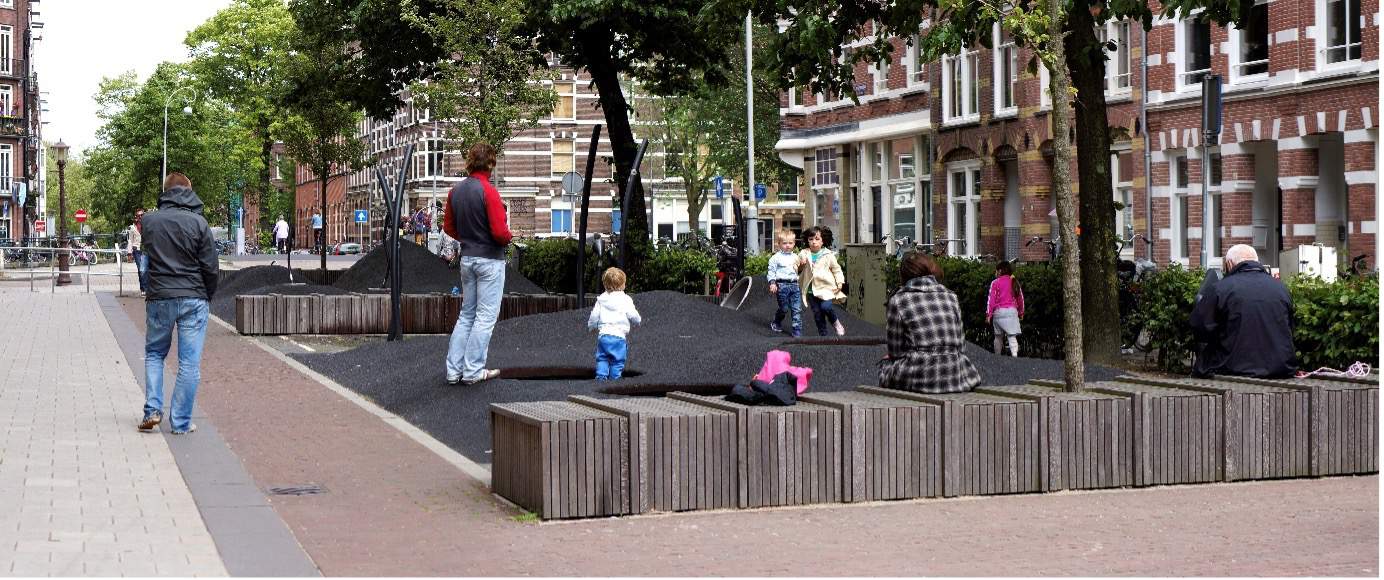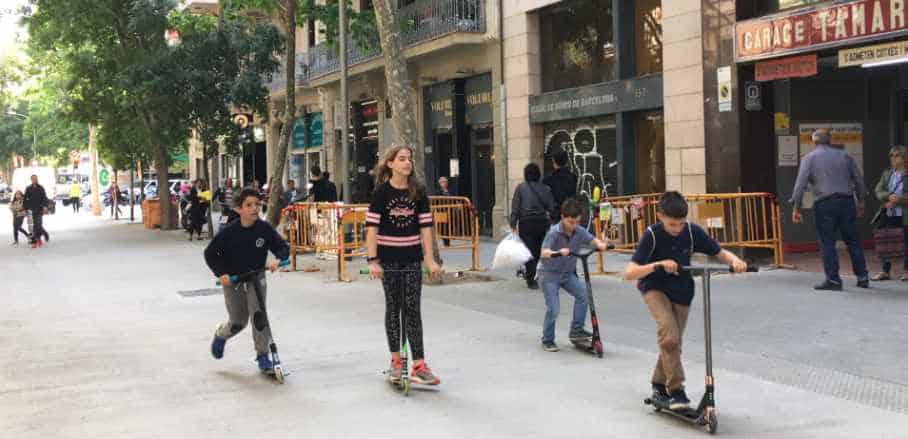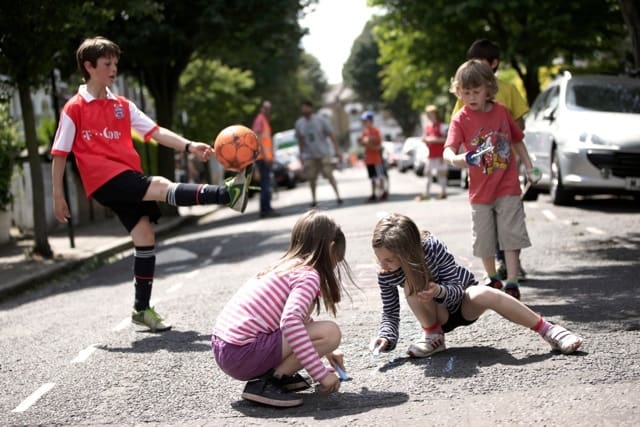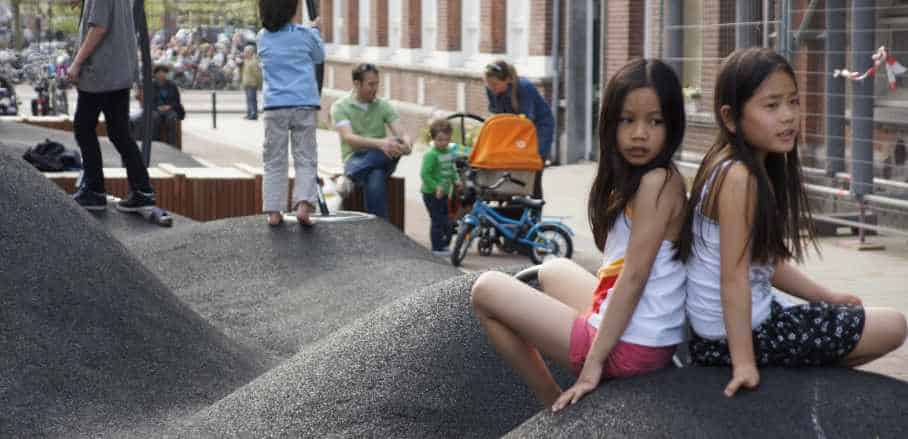Fall and Rise of Streets as Vital Public Spaces for Children
From Amsterdam’s playful Potgieterstraat to Barcelona’s superblocks and Bristol’s ‘Playing Out’ movement, Sudeshna Chatterjee is exploring how urban landscapes are transforming to be more child-friendly.
Streets are not just ordinary spaces in the city: UN-Habitat considers them to be one of the most important public spaces of urban life, that are accessible and enjoyable by all for free and without a profit motive. Streets also have a history of being much more than just roads, especially for children. However, over the years and for various reasons, streets stopped being the most important everyday place for children. Despite this decline, there is good news! Efforts to revive streets as child-friendly places are gaining momentum around the world, ensuring kids can enjoy their everyday freedoms to the fullest.
For children living in poverty, streets become essential playgrounds, providing space for play and socializing, in the absence of access to parks, playgrounds, and other designated formal recreation spaces for children.
Street as Children’s Places
Adults and children have considerably different perceptions and uses of streets. Drawing from numerous studies conducted during the 1970s and 80s, Robin Moore emphasised that for most adults, typically streets are functional resources of easy everyday mobility and for parking cars. However, children perceive streets quite “differently, as play opportunities discovered in lampposts, curb stones, gutters, inspection chamber covers, overhead wires, parked cars, trees, piles of leaves, flights of steps, gates, bollards, hedges, retaining walls, driveways, building entrances, bus stops, mailboxes, street signs, and benches”. (Moore, 1987, p. 45 )
When children can freely explore and utilise their imagination, a street becomes a children’s place. These street features are rich in affordances of children’s play. Studies have consistently shown that most everyday play occurs on the street when children have some degree of free mobility within their neighbourhoods and permission to play out.
Fall of Streets and Shrinking Childhood Territories
Sadly, the days of carefree play and children’s ability to freely move around their neighbourhoods and local areas have declined all over the world. Several factors contribute to this decline, with one prominent concern being the ever-increasing vehicular traffic, that exposes children to the risk of road crashes. According to the WHO Global Status Report on Road Safety 2018, road traffic injuries are now the leading cause of death for children and young people aged 5-29 years.
But that’s not all – there are other reasons that keep children away from the streets. The fear of encountering strangers, and the over-scheduling of structured activities that leave little time for children to simply play outside in the neighbourhood. Additionally, gangs, drug dealing, and bullying, create an unsafe environment, and further discourage outdoor play.
Even the local residents’ intolerance of noisy play becomes a hindrance. Moreover, the grim issues of toxic air, uncollected garbage, and unsafe site conditions cast a shadow over the once lively play spaces.
Rise of Streets as a Vital Public Space for Children
The Decade of Action for Road Safety (2011–2020 and 2021-2030) as mandated by the United Nations General Assembly, served as an important driver that brought together different sectors to jointly address road safety as a global public health issue. The primary objectives included strengthening partnerships and networks, as well as mobilising resources for a collective effort.
One laudable effort in this direction is the Designing Streets for Kids guide (2020), by the National Association of City Transportation Officials (NACTO), supported by a consortium of philanthropic organisations. This guide focuses specifically on creating better streets for children through design and planning. While recognising the great variation and complexity of streets globally across context, culture, and aesthetic preferences, this initiative believes that cities across the world often face similar street design challenges and opportunities as well.
Let me share a couple of examples that highlight the possibilities of street design that put children’s needs in focus.
Street design for play in Amsterdam: In the heart of Amsterdam lies a street called Potgieterstraat that underwent a remarkable transformation. Located in an old neighbourhood with narrow streets and limited public squares and greens, the district decided to focus on prioritising the well-being of children and pedestrians.

Potgieterstraat: Transformed into a serene playscape, this avenue is now exclusively accessible to pedestrians and bicycles, all while preserving the green canopy of trees. © Carve NL
With citizen participation at the core of this process, they brought in the landscape architecture firm Carve. Their task was to reprogram Potgieterstraat as a playscape, exclusively accessible to pedestrians and bicycles while retaining all the trees.
Carve’s vision came to life with an undulating rubberised play landscape with many play features and street furniture to enable socialisation for all ages. The design was implemented by the municipality of Amsterdam and resulted in a child-friendly public space that has become the heart of community gatherings.
Reclaiming public spaces for play in Barcelona: In 2018, Barcelona launched its Plan for Play in Public Spaces to make Barcelona a playable city by 2030. The plan aims to improve and diversify play and physical activity opportunities in public spaces, both by building on existing programs and creating new ones.

The Plan for Play aims to make Barcelona a playable city by 2030. © Thomson Reuters Foundation/Sophie Davies
The Plan for Play leveraged Barcelona’s famous superblocks experiment. This experiment involved limiting traffic to major peripheral roads around nine square blocks of neighbourhoods, creating a haven for children to reclaim street spaces for play and exploration. Barcelona has big plans to expand it across the city’s entire central grid.
Over the next decade, Barcelona will undergo a remarkable transformation, turning the city centre into a greener, pedestrian-friendly area with 21 new pedestrian plazas at intersections supportive of play.
Play streets that activate play on any local street: Play streets, the concept of temporarily closing down streets to motorised traffic to allow children a safe space to play have a long history dating back to the early twentieth century in New York. Since then several UK and European cities have embraced this idea, making it one of the best examples of claiming time and space for children’s play in the public street right outside their homes.

Children are reclaiming the streets in Bristol with the help of Playing Out, a parent- and resident-led movement. © Playing Out
In 2009, a group of parents in Bristol, UK, set the wheels in motion when they held the first informal “playing out” session, which expanded to five streets the following year. The success of these play sessions caught the city council’s attention, leading to a change in policy. Now, streets could be closed to traffic and opened to play for up to three hours a week. Playing Out is now a national advocacy group, a direct spin-off of the original group of Bristol activist parents, and they facilitated the expansion of Bristol play streets to 660 streets in 67 local authority areas to activate children’s play in streets and influenced the Australian government’s 1000 Play Streets program.
In conclusion, the evolution of streets from thriving public spaces for children to overlooked or even dangerous territories is currently witnessing a resurgence of efforts to reclaim them as child-friendly places. By embracing innovative street designs, inspiring initiatives, and collective action involving different stakeholders, we have the potential to revitalise streets, creating vibrant, safe, and playful environments for the next generation.
The original version of this article was published as a part of Streets For All : 50 Ideas For Shaping Resilient Cities book, published by My Liveable City. To read more click : https://www.myliveablecity.com/book/detail/streets-for-all-50-ideas-for-shaping-resilient-cities
- Fall and Rise of Streets as Vital Public Spaces for Children - 5. September 2023
